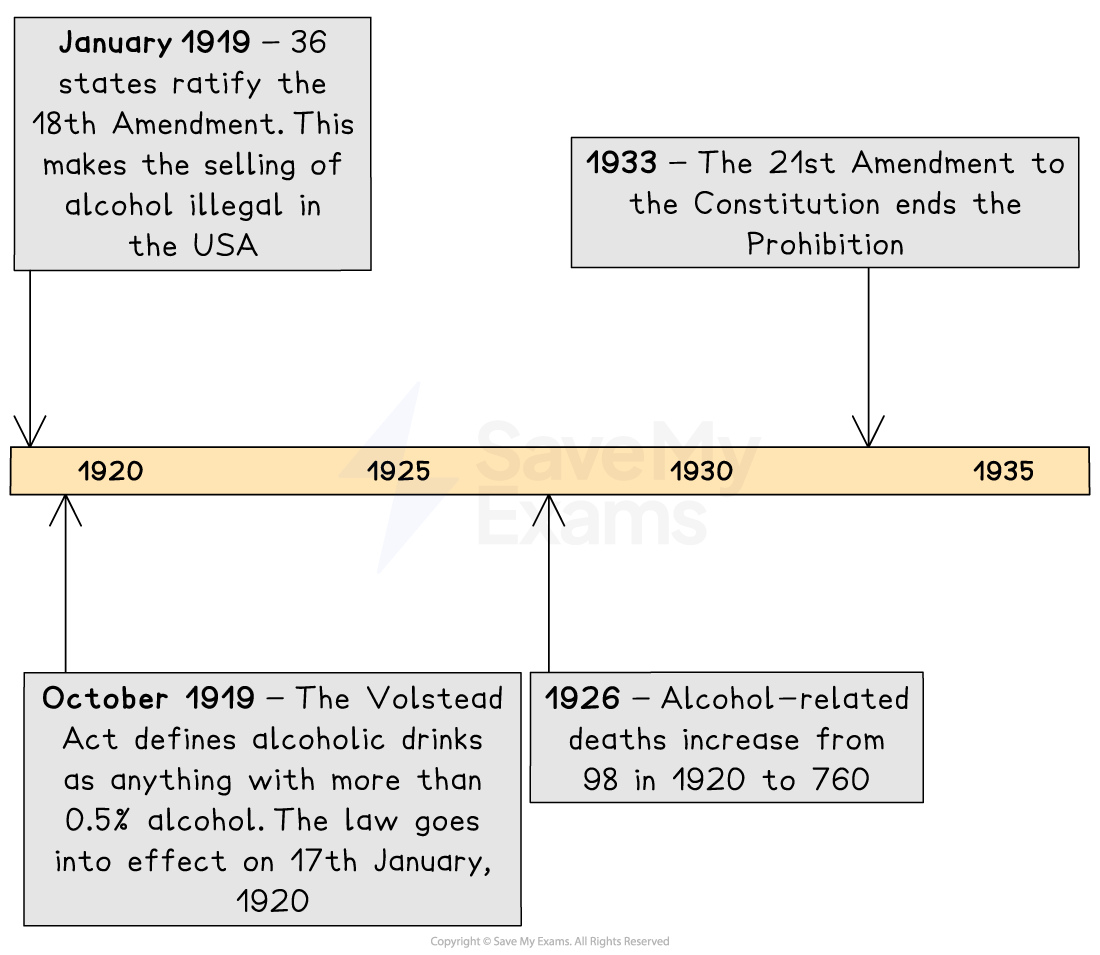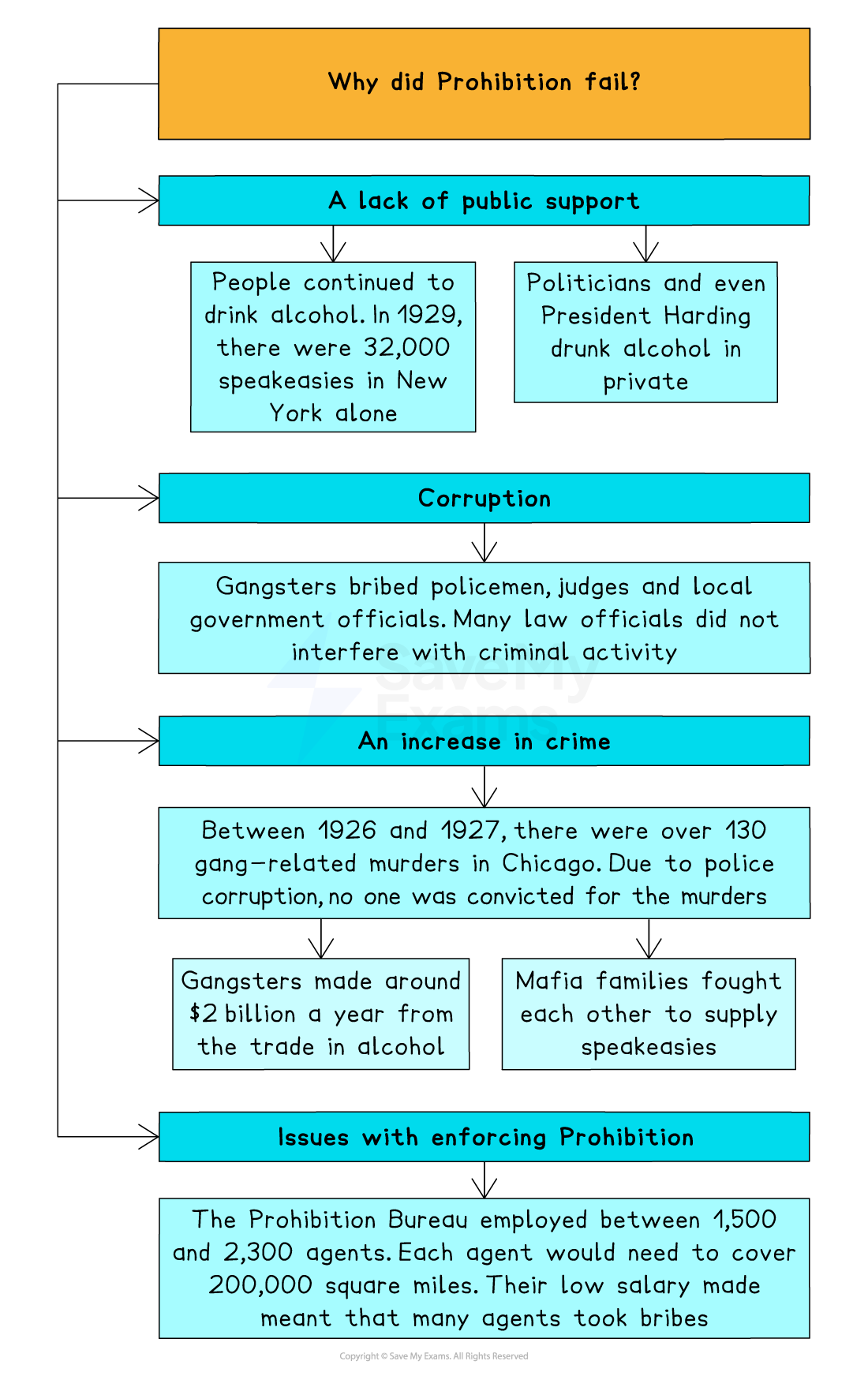Why was Prohibition Introduced & Repealed? (Cambridge (CIE) IGCSE History): Revision Note
Exam code: 0470 & 0977
Timeline & Summary

In the 1920s, the US introduced a law known as prohibition. This was a nationwide ban on the production, sale and transportation of alcoholic drinks. The US government introduced prohibition because many people believed alcohol was causing social problems, such as crime, poverty and family issues. They hoped that, by banning alcohol, society would become healthier and more law-abiding.
Prohibition did not work out as planned. Instead of reducing alcohol consumption, it led to a rise in illegal activities, such as bootlegging, which involved people making and selling alcohol secretly. Gangsters such as Al Capone became powerful figures by smuggling and distributing alcohol. Every city in the USA had an issue with gangs, which created a lot of violence and crime in cities across the country. Prohibition also led to corruption among law enforcement officials. Bootleggers bribed police officers to turn a blind eye to their illegal activities, which undermined the rule of law and eroded public trust in the government.
Prohibition had unintended consequences and caused more problems than it solved. While it aimed to improve society, it instead fuelled crime, corruption and social unrest in the US throughout the 1920s. As a result, the government repealed the act in 1933.
What was prohibition?
Prohibition made the production, selling and distribution of alcohol illegal
This was a federal law
As a result, it applied to all states in the US
Prohibition took some time to come into law
Discussions about prohibition began in 1917
In 1919, the government passed two acts to legalise prohibition
The 18th Amendment made the sale of alcohol illegal
The Volstead Act classified alcohol as any drink that had ever contained more than 0.5%t alcohol
Prohibition began in 1920 and lasted until 1933
Why was prohibition introduced?
Pressure from religious groups
The Methodists and Baptists did not agree with drinking alcohol. They believed that drinking alcohol was a sin
Pressure from temperance groups
The Anti-Saloon League (ASL) and the Women’s Christian Temperance Union (WCTU) campaigned for prohibition
They blamed alcohol for causing many social issues in the US, including poverty, crime and broken marriages
The First World War
Many German immigrants owned alcohol companies, especially breweries
The public viewed buying alcohol from German immigrants as unpatriotic
Attitudes of business men
Powerful industrialists did not like their workers drinking
For example, Henry Ford believed it decreased efficiency and led to his workers taking sick days
Ford influenced federal politics
Anti-immigrant feelings
Immigrant communities such as the Irish, Germans and Eastern Europeans had a reputation for drinking a lot of alcohol
Support for prohibition was linked to a dislike for these communities in the US
Why did prohibition fail?
There were several reasons why prohibition failed, including:
An increase in crime
The lack of public support
Corruption
Problems enforcing prohibition

The end of prohibition
By the 1930s, the US government could no longer justify prohibition
Enforcing prohibition cost the US government $13.4 million
The government was losing out on $11billion of revenue from taxing alcohol sales
US citizens’ opposition to prohibition increased
Businessmen no longer wanted prohibition due to the increase in crime
The Great Depression led to mass unemployment
Legalising alcohol production would create more jobs
Campaign groups such as the Women’s Organisation for National Prohibition Reform protested for the end of prohibition
They hated the social impact of prohibition, especially the number of arrests
In 1933, President Roosevelt repealed the 18th Amendment
The banning of alcohol was now a state decision rather than a federal law
This meant that the ban remained in some states and not others
Worked Example
Describe the impact of prohibition on American society in the 1920s
[4 marks]
Answer:
One impact of prohibition on American society in the 1920s was the rise of organised crime and gangsters in cities across the United States. With legal alcohol banned, people turned to criminals such as Al Capone to provide bootlegged alcohol. Criminal gangs made millions in profits by smuggling and bootlegging alcohol.
Another impact of prohibition on American society in the 1920s was that it damaged public trust in law enforcement. Gangsters were incredibly rich and could afford to pay the police, and even judges, enormous bribes to turn a blind eye to their criminal activities.
Examiner Tips and Tricks
You should look to spend no more than five to seven minutes on the four-mark questions on this paper. On the six-mark question, you should spend between 10 and 12 minutes. For the ten-mark question, you should take between 20 and 25 minutes to answer it.

Unlock more, it's free!
Did this page help you?